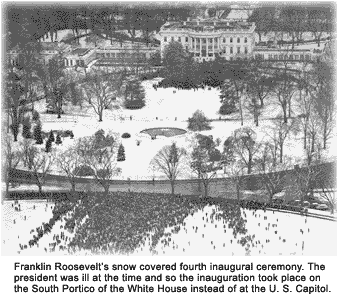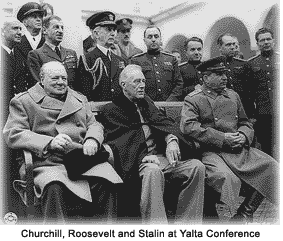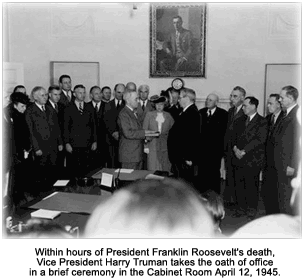A fourth term
In June 1944, the Republican Party nominated Governor Thomas E. Dewey of New York for president. At that point, President Franklin D. Roosevelt had not announced if he would run for a fourth term. He finally declared that he wanted to retire — but felt it was his obligation to run again. The president explained that he desired to preclude a wartime leadership change. Numerous political leaders believed that FDR might not survive a fourth term, but the president handily won his re-nomination and the presidential election with Senator Harry S. Truman of Missouri as his vice-presidential nominee.
It should be noted that Henry A. Wallace was FDR's vice president during his third term. Had Wallace run for the fourth term, Roosevelt might not have been reelected. Wallace's unbending stand in favor of civil rights was unpopular with conservative Southern Democrats.
Roosevelt was in poor health when he began his fourth term. A series of colds had bothered him for more than a year. He had lost about 15 pounds. In Fall and Winter 1944, he was busy directing his legislative program and dealing with increasingly difficult international problems. The election campaign of 1944 weakened him further.
 Roosevelt's inaugural address of January 1945 was one of the shortest in American history, lasting only six minutes. The president declared that Americans had learned, "We cannot live alone at peace, that our own well-being is dependent on the well-being of nations far away...."
Roosevelt's inaugural address of January 1945 was one of the shortest in American history, lasting only six minutes. The president declared that Americans had learned, "We cannot live alone at peace, that our own well-being is dependent on the well-being of nations far away...."
The D-Day landings on the Normandy beaches of France on June 6, 1944, were followed by the Allied invasion of Germany in six months. By April 1945, victory in Europe was certain. The unending stress and strain of the war literally wore Roosevelt out. By early 1944, a full medical examination disclosed serious heart and circulatory problems; and although his physicians placed him on a strict regime of diet and medication, the pressures of war and domestic politics still weighed heavily on him.
Economic Bill of Rights
As World War II drew to a close and industrial production dropped off, the question of full employment once again came to the fore. President Roosevelt's program for individual economic security, promised in his message to Congress in January 1944, was presented in the Full Employment Bill of 1945. It called for the federal government to gear its investments and expenditures to provide jobs for everyone. Congress devoted intensive study to the bill throughout 1945. However, the Full Employment Bill became the considerably whittled-down Employment Act of 1946. That act generated the Council of Economic Advisors, which had no teeth but to advise the president on matters of economic policy.
The so-called Second Bill of Rights was a proposal made by FDR in his State of the Union Address on January 11, 1944, to add a second bill of rights to the Constitution (text). Roosevelt's rationale was that the political rights granted by the Constitution (narrative) and the Bill of Rights had "proved inadequate to assure us equality in the pursuit of happiness." Roosevelt's remedy was to create an "economic bill of rights" that would guarantee the right:
Roosevelt asserted that having those rights would guarantee American security, and that America's place in the world depended upon how far they and similar rights were carried into practice.
In Roosevelt's Second Bill of Rights are found the elements of massive social change in postwar America. The bill did not pass, but a certain mentality ensued in Congress that lasted a full 40 years. Here is found the spirit of The Social Security Act, the GI Bill, the Civil Rights Movement, the Equal Rights Amendment (ERA), Affirmative Action, universal health care as promoted by then Senator Hillary Clinton, health-care reform of 2009-10, and what may be termed the “Welfare State."
The Yalta Agreement
The scene of the famous Yalta Conference of February 4 through 11, 1945, was the summer palace of Czar Nicholas II on the Black Sea coast of the ravaged Crimea, only recently liberated from the Nazis. The last meeting of the “Big Three” Allied leaders — Roosevelt, Churchill and Stalin — opened as victory in Europe was imminent. Roosevelt had been advised by the Joint Chiefs of Staff that Japan was capable of continued resistance and that Russian participation in the Pacific theater would save a million American casualties.
On February 11, 1945, the three leaders issued the Crimea Declaration. It repeated the principles of the Atlantic Charter and the Casablanca conferences. The leaders mapped out a final assault on Germany and the postwar occupation of that country. They also planned a meeting in San Francisco to lay the foundations for the peacetime United Nations organization.
 In a secret agreement, Russia promised to enter the war against Japan following Germany's surrender. In return, Russia was to receive the Kuril Islands and other concessions.
In a secret agreement, Russia promised to enter the war against Japan following Germany's surrender. In return, Russia was to receive the Kuril Islands and other concessions.
While reporting on the Yalta meeting to Congress on March 1, Roosevelt made one of his rare public references to his physical handicap. "I hope that you will pardon me for this unusual posture of sitting down...," he said, "but ... it makes it a lot easier for me not to have to carry about 10 pounds of steel around at the bottom of my legs.”
Here, the roots of the United Nations (UN) and the North Atlantic Treaty Organization (NATO) were set. The future organization of Europe and the dispensation and partitioning of Germany and its capital city, Berlin, were agreed upon. Here the first dominos were tipped, triggering the Cold War and containment.
The Act of Chapultepec
Long since having rejected Isolationism, Roosevelt reached out to Latin America. On the whole, Latin-American countries reciprocated President Roosevelt's Good Neighbor Policy by supporting the United States during World War II. Only Argentina and Chile withheld full aid, mostly because of large numbers of Axis sympathizers within their borders.
Multilateral cooperation reached a peak at the Inter-American Conference in Mexico City in February and March 1945. The conference reaffirmed the unity of the American nations and reached broad agreements on social and economic problems. The most important outcome of the conference was the Act of Chapultepec, adopted on March 3, which established the first multilateral collective security system in the Western Hemisphere.
Creation of the United Nations
Anticipating some congressional resistance to American participation in the United Nations, President Roosevelt chose a bi-partisan delegation, including distinguished members of Congress, to attend the San Francisco Conference that would set up the organization. The selection of Senator Arthur Vandenberg, a Republican from Michigan, was particularly important because of his influence in the Republican Party. While Vandenberg had led isolationists opposing American involvement in the European war in the 1930s, by 1945, he had become the most international-minded of Republican leaders. His effective work at the conference exerted a powerful influence on quelling Republican opposition to the United Nations Charter when it was brought before the Senate for ratification. The United Nations Charter was adopted by 50 nations on June 25, 1945. The U.S. was a signatory.
The death of America's father figure
On March 29, 1945, the president left the White House for a rest at Warm Springs. He had prepared a speech for broadcasting on April 13. Roosevelt had written: "The only limit to our realization of tomorrow will be our doubts of today. Let us move forward with strong and active faith."
 April 12 began as an ordinary day. The president read newspapers and mail that had been flown down from Washington. Before an evening barbecue, Roosevelt worked at his desk while an artist, Elizabeth Schoumatoff, painted his portrait. Suddenly he fell over in his chair. "I have a terrific headache," he whispered. Those were Roosevelt's final words. He died a few hours later of a cerebral hemorrhage. He was 63 years old. His death came on the eve of complete military victory in Europe and within months of victory over Japan. As news of his death spread, a crowd gathered in front of the White House, silent with grief. Millions of people in all parts of the world mourned the dead president.
April 12 began as an ordinary day. The president read newspapers and mail that had been flown down from Washington. Before an evening barbecue, Roosevelt worked at his desk while an artist, Elizabeth Schoumatoff, painted his portrait. Suddenly he fell over in his chair. "I have a terrific headache," he whispered. Those were Roosevelt's final words. He died a few hours later of a cerebral hemorrhage. He was 63 years old. His death came on the eve of complete military victory in Europe and within months of victory over Japan. As news of his death spread, a crowd gathered in front of the White House, silent with grief. Millions of people in all parts of the world mourned the dead president.
Vice President Truman took office as president.
Epilogue
FDR, handicapped by polio, then later, an ailing heart, had seen America through some of its most dire days, through three full and one partial presidential terms. They included the Great Depression, the Dust Bowl of the Midwest and World War II. The accomplishments of the New Deal, that daring, innovative mega-scheme that ushered in a peaceful social revolution, has earned the nation's judgment of Roosevelt as one of the great presidents of U.S. history.
He did not witness all the fruits of his involvement, such as the Manhattan Project, the United Nations, and Social Security, but all Americans live with them. Many hold dear the memory of those days in the mid-20th century, cognizant of his devotion to America's security and the plight of the common man.